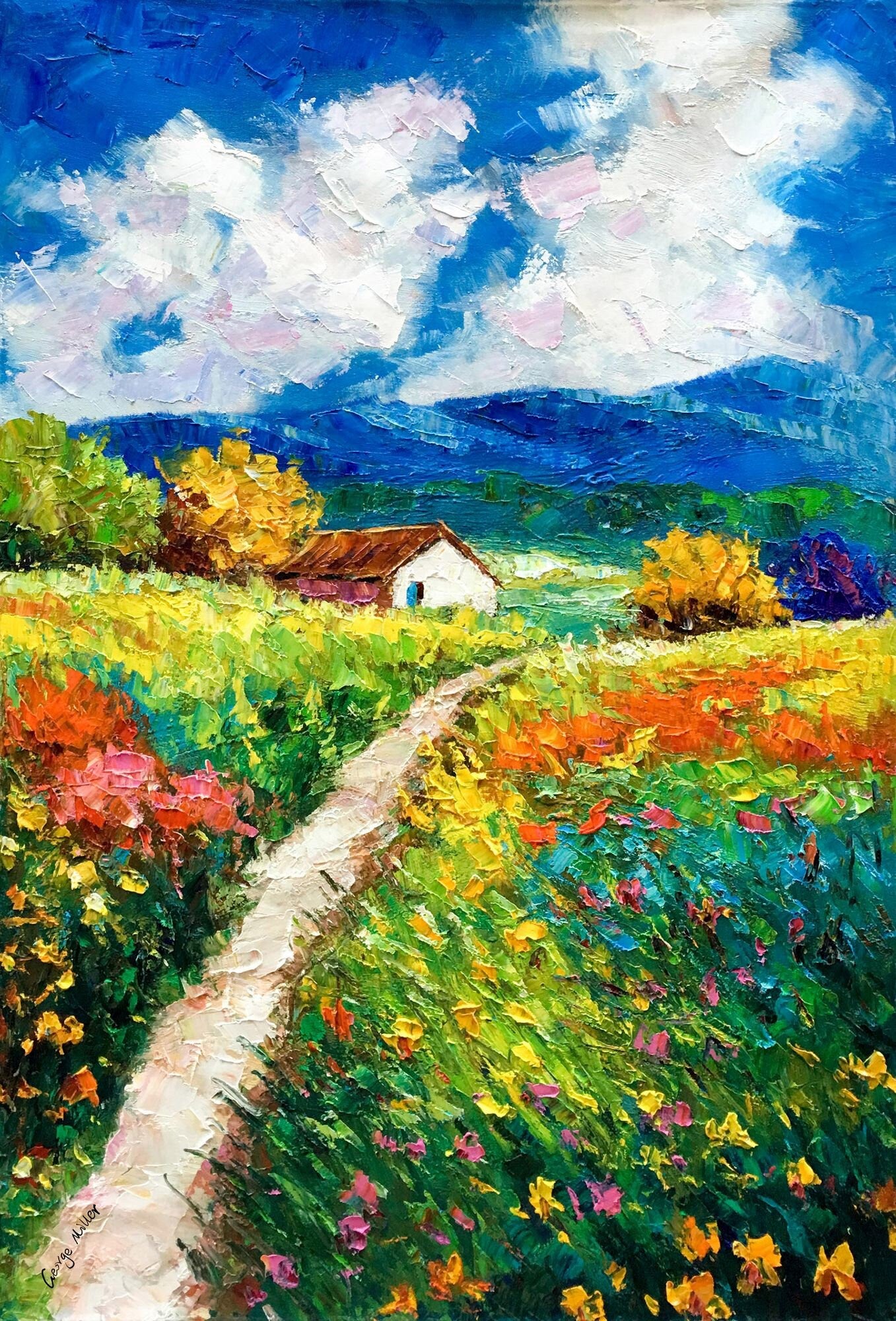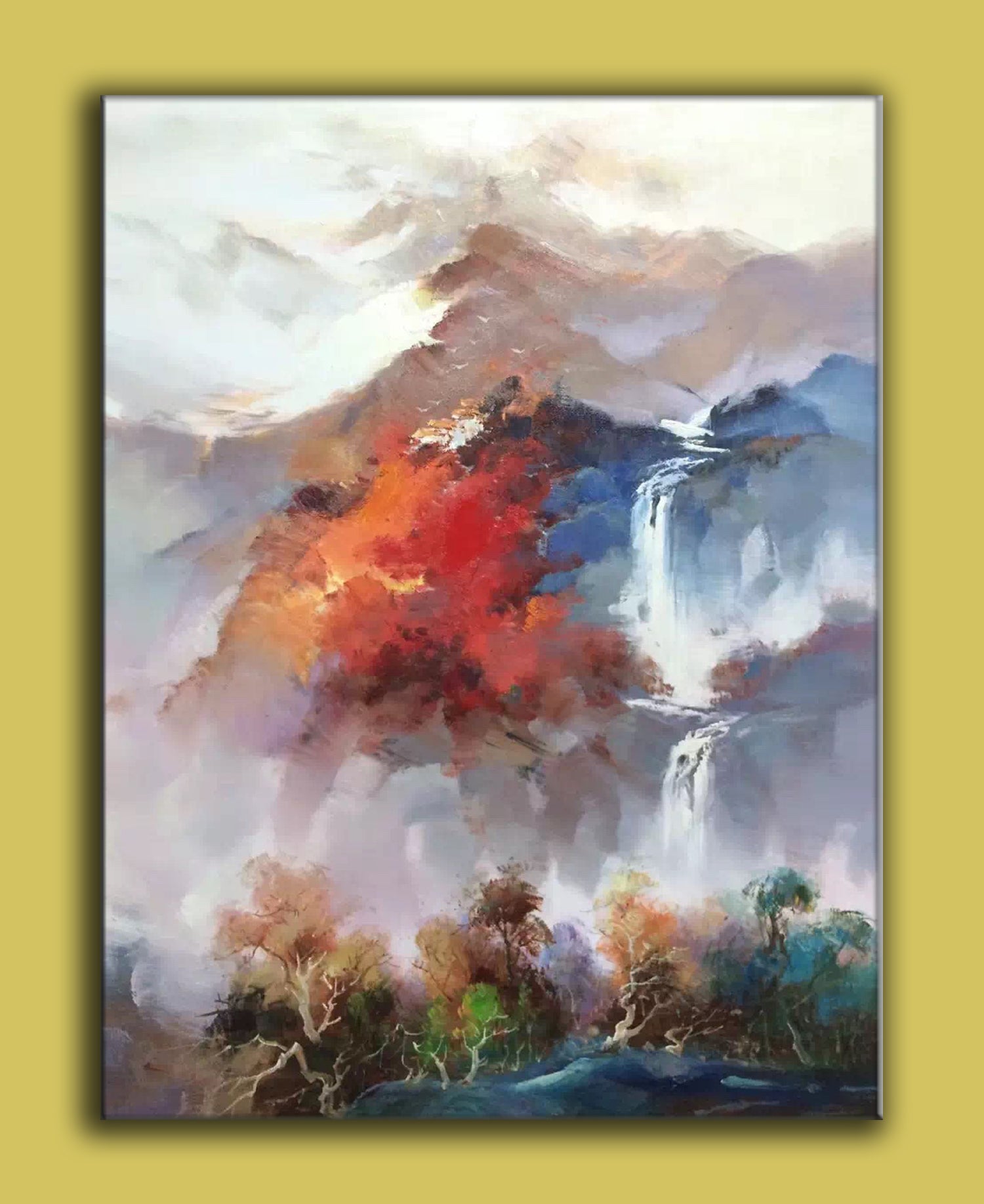Colorful Landscape and Nature Oil Paintings for Sale
Colorful Landscape and Nature Oil Paintings for Sale
Blog Article
Exploring All Concerning Oil Paintings: An Overview to Comprehending Their Beauty and Value
Oil paintings have actually mesmerized audiences for centuries, providing a glance into the artistic proficiency of numerous periods. Their rich background is intertwined with cutting-edge strategies and profound emotional expression. Understanding the products and techniques behind these art work can improve recognition. In addition, the marketplace for oil paintings presents possibilities for investors and collectors alike. As one discovers this interesting globe, the concern occurs: what makes an oil paint really important?
The Background of Oil Paint: A Trip Through Time
Oil paint has origins that date back to ancient times, it absolutely grew during the Renaissance, when musicians uncovered its versatility and abundant shade capacity. Early instances can be mapped to the 7th century, with strategies progressing notably throughout cultures. The tool ended up being famous in Northern Europe in the 15th century, specifically with the jobs of musicians like Jan van Eyck, who pioneered its usage for thorough realism and vibrant hues. This period marked a departure from tempera paints, permitting better depth and appearance. As oil painting spread, it influenced plenty of musicians, resulting in work of arts by distinguished figures such as Leonardo da Vinci and Rembrandt. The medium's tradition continues, shaping the art world well into contemporary times.
Understanding Oil Repaints: Materials and Techniques
As artists discover the globe of oil paints, they come across a diverse selection of materials and techniques that specify this medium. The main elements of oil paint consist of pigments, which provide color, and drying oils, such as linseed, that bind the pigments and promote application. Numerous additives can customize the paint's structure and drying time, boosting convenience. Strategies like glazing, where clear layers are developed, and impasto, which includes applying thick paint, enable for various visual results. Furthermore, using brushes, scheme blades, and also fingers can produce one-of-a-kind textures and coatings. Recognizing these methods and materials makes it possible for musicians to totally express their creative thinking and accomplish the desired effect in their art work.
The Function of Shade in Oil Paints
Color plays a critical role in oil paintings, affecting both visual charm and emotional vibration. Recognizing shade theory fundamentals, consisting of the relationships between hues, can boost an artist's capability to convey state of mind and environment. Furthermore, understanding color blending techniques allows for better deepness and richness in a painting's combination.

Color Theory Basics
Comprehending shade concept is vital for musicians dealing with oil paints, as it develops the structure for creating visually appealing and unified make-ups. Color theory incorporates the study of just how colors communicate, the color wheel, and the relationships between primary, secondary, and tertiary colors. Musicians use corresponding colors to boost contrasts and create focal points, while similar colors advertise unity and cohesiveness within a piece. In addition, the concepts of warm and awesome colors affect the understanding of deepness and room in a painting. Comprehending these principles enables artists to adjust color effectively, guiding the audience's eye and connecting their intended message. Proficiency of shade theory ultimately enriches an artist's capacity to share emotions and concepts with their job.
Emotional Influence of Shade
The psychological effect of color in oil paintings plays a vital duty in how visitors view and link with art work. Colors stimulate specific sensations and moods, affecting the customer's emotion. Warm shades like oranges and reds can create a sense of heat and energy, while awesome tones such as blues and greens frequently evoke peace or self-contemplation. Artists purposefully select color combinations to improve narrative elements, directing the audience's emotional trip. The saturation and comparison of colors better enhance these impacts, drawing attention and producing emphasis. Inevitably, the interplay of shades in oil paintings not just boosts their visual appeal however also serves as an effective medium for emotional expression, enriching the viewer's experience and interpretation.
Color Combining Techniques
While many facets of oil painting add to the general make-up, grasping color mixing techniques is essential for accomplishing desired results and depth. Shade blending can be approached with numerous approaches, consisting of the additive and subtractive processes. Additive mixing involves incorporating colors of light, while subtractive blending depends on pigments, where shades mix to create new tones. Musicians frequently utilize a restricted scheme to develop harmonious works, comprehending the connections between key, additional, and tertiary shades. Techniques such as glazing and scumbling additionally improve deepness and brightness. By masterfully blending shades, an artist can stimulate feelings, develop centerpieces, and attain a feeling of realism, inevitably elevating the painting's aesthetic and psychological influence.
Famous Oil Painters and Their Iconic Functions

Famed for their mastery of shade and technique, oil painters have actually created a few of the most popular artworks in background. Prominent musicians like Vincent van Gogh captivated target markets with his emotive brushwork in "Starry Night," while Claude Monet's "Impact, Daybreak" laid the groundwork for Impressionism. Leonardo da Vinci's "Mona Lisa" stays an enduring sign of creative genius, showcasing his skill in recording human expression. At the same time, Rembrandt's "The Night Watch" illustrates his innovative use light and darkness. Various other noteworthy numbers include Pablo Picasso, who reinvented contemporary art with his bold experimentation in works like "Les Demoiselles d'Avignon," and Georgia O'Keeffe, whose lively depictions of landscapes and flowers helped define American innovation. Each artist's website one-of-a-kind design added significantly to the oil painting landscape.
Just how to Assess the Top Quality of an Oil Paint
Assessing the high quality of an oil painting includes a cautious evaluation of workmanship techniques, as well as an analysis of color and composition. Observing brushwork, layering, and the application of paint can reveal the musician's skill degree. Additionally, the interplay of colors and the total arrangement of components add substantially to the painting's visual worth.
Examining Workmanship Methods
A meticulous evaluation of workmanship techniques is important for determining the high quality of an oil painting. Evaluators must first check out the application of paint; thick, distinctive brushstrokes might suggest a proficient hand, while overly uniform applications could suggest a lack of depth. oil paintings for sale. The layering technique is also important; the existence of lusters and differed density can boost luminance and complexity. Furthermore, the top quality of the products made use of, such as the canvas and pigments, plays a substantial duty in resilience and total aesthetic. Attention to information in elements like edges and shifts in between shades shows the musician's dedication to their craft. Inevitably, these methods add to the paint's emotional effect and market worth, functioning as indications of the artist's skill and intent
Analyzing Shade and Structure
While reviewing the quality of an oil painting, one should concentrate on the interplay of color and composition, as these components are essential to the art work's general influence. Color selections can establish and stimulate emotions mood; therefore, the musician's combination need to be analyzed for consistency and comparison. A healthy make-up directs the customer's eye and creates a feeling of unity. Musicians frequently use techniques like the regulation of thirds or leading lines to improve aesthetic passion. Additionally, making use of light and shadow can add depth, enhancing the three-dimensionality of the painting. Ultimately, a successful oil paint weds shade and make-up, involving the viewer and inviting a deeper appreciation of the musician's vision and strategy.
Taking care of and Preserving Oil Paintings
Appropriate care and preservation of oil paints is important for keeping their integrity and durability. To protect these art work, it is vital to display them far from direct sunshine, which can trigger fading and discoloration. Keeping a stable atmosphere with controlled temperature level and humidity additional help in avoiding damages. Cleaning need to be done gently utilizing a soft, dry fabric, staying clear of any severe chemicals that could harm the paint or varnish. Normal inspections for indicators of wear and tear, such as breaking or flaking, are a good idea. When moving or storing oil paintings, proper padding and framing are required to prevent physical injury. Ultimately, thorough treatment contributes to the visual charm and worth of oil paintings gradually.
The Market for Oil Paints: Investing and accumulating
Recognizing the marketplace characteristics for oil paintings is important for collectors and capitalists alike. The worth of these art work is influenced by numerous factors, consisting of the artist's credibility, historical value, and current patterns. Collection agencies typically look for items that resonate directly while considering potential admiration in worth. Public auctions and galleries act as key places for acquiring and selling, with costs changing based on demand and rarity. Investing in oil paintings needs research study right into the marketplace, as well as an understanding of authenticity and provenance. Additionally, emerging musicians may provide opportunities for substantial returns, while developed names can command high prices. On the whole, a critical approach to gathering can generate both visual pleasure and monetary rewards.

Frequently Asked Questions
What Are the Environmental Impacts of Oil Paint Materials?
The environmental impacts of oil painting materials include the launch of volatile organic compounds (VOCs), damaging waste generation, and source extraction for pigments. These variables add to pollution and environmental degradation, raising problems amongst eco aware musicians and customers.
How Do Different Canvases Influence Oil Painting Outcomes?
Various canvases affect oil paint results substantially. Surface, absorbency, and texture high quality can change paint application, drying out times, and shade vibrancy. Artists frequently select details canvases to accomplish preferred results and boost their creative expression.
Can Oil Paintings Be Restored if Harmed?
Oil paints can certainly be brought back if harmed. Expert conservators utilize numerous techniques to fix splits, clean surfaces, and address staining, ensuring that the art work maintains its original appeal and worth for future generations.
What Are the Indicators of an Original Oil Painting?
The signs of an initial oil painting consist of noticeable brush strokes, texture variations, and an unequal canvas weave (oil paintings for sale). In addition, credibility might be validated with provenance, trademarks, and the existence of a varnish layer distinct to oil mediums
How Has Technology Influenced Modern Oil Painting Techniques?
Modern technology has actually considerably affected modern oil paint techniques by presenting electronic tools for planning, improved products for texture and longevity, and on-line platforms for sharing and marketing art, consequently broadening artists' innovative opportunities and target market get to. Oil painting has roots that date back to ancient times, it truly grew throughout the Renaissance, when artists discovered its flexibility and abundant shade possibility. The psychological influence of color in oil paints plays a critical function in exactly how audiences connect and regard with artwork. While many elements of oil painting contribute to the general composition, mastering shade blending methods is necessary for accomplishing preferred effects and deepness. Evaluating the top quality of an oil paint entails a careful evaluation of craftsmanship techniques, as well as an analysis of shade and structure. While reviewing the high quality of an oil painting, one should focus on the interplay of color and composition, as these aspects are fundamental to the artwork's total impact.
Report this page